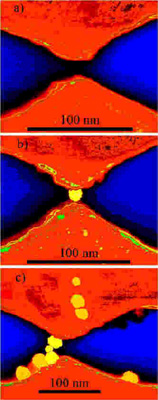Electrostatic Trapping
Conducting nano particles (molecules, metal clusters, ..) can be positioned between electrodes using electrostatic trapping. Particles should be in the vicinity of closely spaced electrodes. For example, electrodes can be immersed into a liquid solution with molecules. If a voltage is applied to the electrodes, the electric field will be the strongest in the gap between the electrodes. Particles are polarized by the field and are attracted to the point of the strongest field, i.e., right to the gap. The positive side of the polarized particle is attracted to the negative electrode and the negative side of the particle is attracted to the positive electrode. After one particle is trapped a current flows between the electrodes. If a resistor connected in series with the electrodes is big enough, the main part of the applied voltage will drop on this resistor. Therefore trapping of the second particle is prevented. The principle of electrostatic trapping was tested on Pd nano particles soluble in water. Averaged size of particles is 15-20 nm. Top picture below shows two Pt electrodes (red) separated by a gap of about 15 nm. Next picture shows the same electrodes after the ET. The electrodes are now bridged by a single Pd nano particle. Bottom picture illustrate the case when the gap is larger than the particle size. Here, a few (three in this picture) particles are connected in series and together bridge
